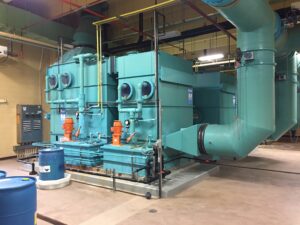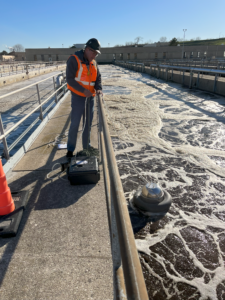What Is Industrial Odor Control? A Plain-Language Guide for Facility Managers
 Odor control is a major concern for many facilities, especially in wastewater treatment, food processing, composting, and other industrial operations. When odors become noticeable off-site or inside the plant, they can lead to complaints, regulatory attention, and problems with staff and neighbors.
Odor control is a major concern for many facilities, especially in wastewater treatment, food processing, composting, and other industrial operations. When odors become noticeable off-site or inside the plant, they can lead to complaints, regulatory attention, and problems with staff and neighbors.
At Webster Environmental Associates (WEA), one of the most common questions we hear is, “What is industrial odor control?” Facility managers often know they have an issue, but they’re not sure where to begin. We’ll explain the basics in simple terms. We’ll walk through what odor control involves, why it matters, and how WEA helps facilities choose the right tools for their needs.
What Industrial Odor Control Actually Means
Industrial odor control is the use of systems and techniques to manage odors that form during operations. The goal is to stop those odors from spreading into the surrounding area. It’s not just about improving the smell—it’s also about staying in compliance with air quality rules and protecting the health of workers and nearby communities.
Odors usually come from specific chemical compounds in the air. The most common ones include:
- Hydrogen sulfide (H₂S): Smells like rotten eggs. It’s often found in wastewater and sludge.
- Ammonia: Sharp, irritating smell, common in food processing and solid waste handling.
- Volatile organic compounds (VOCs): A wide range of chemicals found in industrial processes, often responsible for strong or unusual odors.
Odors can be released from tanks, basins, pipelines, or equipment. Some come from the liquid stream, while others form in the air after materials break down. Odor control starts with identifying the sources and then applying the right treatment method.
Main Technologies Used in Industrial Odor Control
Different types of odors require different treatment strategies. That’s why odor control systems are not one-size-fits-all. At WEA, we look at the actual sources, emission levels, and airflow patterns before recommending a system. The main tools we use include:
- Biofilters: These use a layer of media—like wood chips or synthetic materials—where natural microorganisms break down odors in the air. Biofilters are best for steady odor loads and organic emissions, like those found in composting or wastewater plants.
- Chemical scrubbers: These systems spray air with a chemical solution to absorb and react with odor compounds. They work well for strong or variable odors and are often used for H₂S or ammonia control.
- Carbon adsorbers: These systems pass air through beds of activated carbon. The carbon captures odor compounds until it needs replacement. This method works best for low-level or intermittent odors.
- Hydrogen peroxide and oxygen injection: These methods treat odors in the liquid phase. By injecting oxygen or peroxide into wastewater lines, we can stop the bacteria that produce sulfides before the gas forms.
Each of these systems has strengths and limits. WEA helps match the right method—or combination of methods—to your site conditions.
Why Industrial Odor Control Matters
 Poor odor control can create serious problems. It can lead to complaints from the public or even legal action from local agencies. In some areas, strong odors may trigger penalties if they violate air quality standards. In other cases, untreated odors inside the plant can affect workers or speed up corrosion of equipment.
Poor odor control can create serious problems. It can lead to complaints from the public or even legal action from local agencies. In some areas, strong odors may trigger penalties if they violate air quality standards. In other cases, untreated odors inside the plant can affect workers or speed up corrosion of equipment.
Odor complaints also damage community trust. Even when a facility is following all rules, bad smells can create the perception that something is wrong. Controlling odors helps keep operations running smoothly and builds better relationships with the public.
Another concern is equipment damage. Hydrogen sulfide, for example, can corrode metal and concrete over time. That means better odor control can also reduce repair costs and extend the life of infrastructure.
How WEA Helps Simplify the Process
WEA specializes in odor control, and we’ve completed over 750 odor-related projects. Our work starts with understanding your facility’s needs. That begins with a site visit, testing, and sampling. We measure odor levels and identify the specific compounds involved.
Once we understand the problem, we recommend treatment options. Our team does not represent any equipment brand, so we only suggest what works best for your site and budget.
We design the system based on actual data. That includes airflow rates, space limits, odor strength, and more. Once the system is installed, we also help with startup, staff training, and long-term maintenance planning.
Some clients come to us for help with a new facility. Others already have an odor control system but are still getting complaints. We help in both cases—whether you’re starting from scratch or trying to improve what’s already in place.
Looking for Real Help? Start with a Call to WEA
If you’re still asking, “What is industrial odor control?” or you think your facility might need it, WEA is here to help. We work with treatment plants, factories, landfills, and other industrial sites across the country.
Our team will talk with you, visit the site if needed, and provide clear advice on what you can do to reduce odors and meet local standards. We’ll guide you through system options, explain the pros and cons, and stay involved through installation and beyond.
Odor control doesn’t have to be overwhelming. Contact WEA to take the first step. We’re ready to help you find a system that works and fits your facility’s needs.
